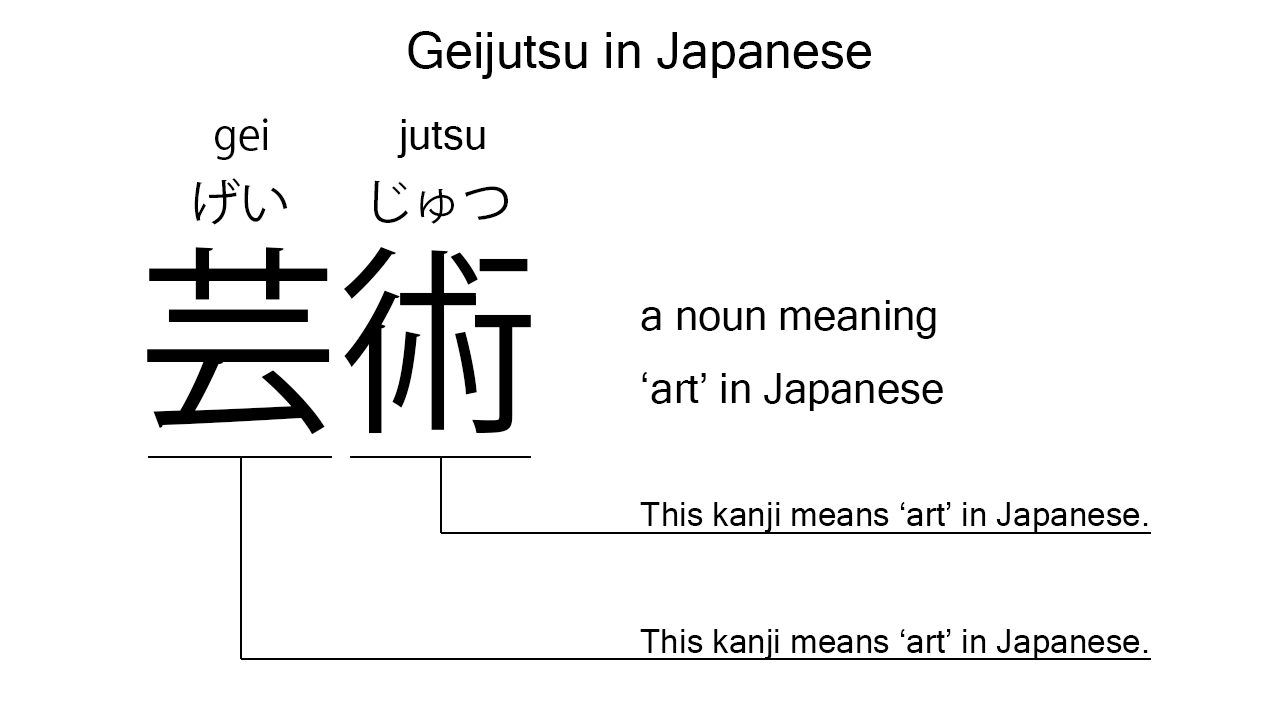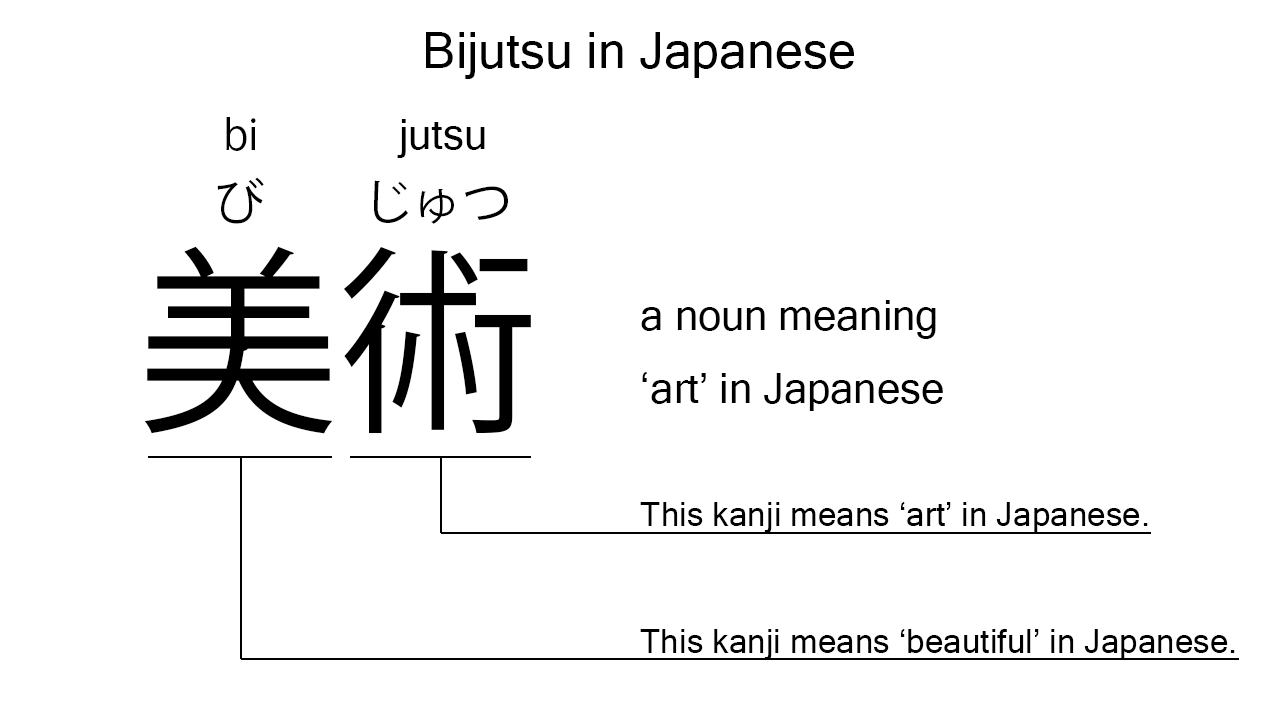How to say “art” in Japanese
The English noun, “art”, has been imported to Japan and it is widely used and thus very understandable. In this blog post, however, I will focus on two Japanese nouns for ‘art’: one is “geijutsu” and the other is “bijutsu”. I will explain them in detail based on their kanji expressions. And also, I will explain how they are different. My explanations would help Japanese learners understand how to say “art” in Japanese. Then, let’s get started!
Contents
- Definition and meaning of “geijutsu”
- Geijutsu in kanji
- Definition and meaning of “bijutsu”
- Bijutsu in kanji
- Summary: geijutsu vs. bijutsu
Definition and meaning of “geijutsu”
Let me start with the definition and meaning of “geijutsu”.
- geijutsu – 芸術 (げいじゅつ) : a noun meaning ‘art’ in Japanese. Normally, this is used to refer to art in general.
The definition and meaning are simple and clear. To understand this noun more clearly, however, let me explain its kanji characters in detail, one by one.
Geijutsu in kanji
The kanji expression of “geijutsu” consists of the following two kanji characters:
- 芸 : a kanji character often used to mean ‘art’, ‘performance’, or ‘acting’ in Japanese.
- 術 : a kanji character used to mean ‘technique’, ‘art’, ‘means’, ‘trick’, or perhaps ‘magic’ in Japanese.
These two kanji characters tell us that “geijutsu” consists of two similar kanji characters which mean ‘art’ in Japanese. What the kanji characters express is, therefore, completely in line with the actual meaning.

When we meet new kanji expressions, we should check their kanji characters in detail to understand their meanings clearly and deeply. In many cases, kanji characters tell us a lot about the meanings of the expressions they form. Actually, here, we could get the better understanding of “geijutsu” through the detailed kanji check above.
So far, I’ve explained the definition and meaning of “geijutsu” together with its kanji characters. Then, let me explain the other one, “bijutsu”, in detail.
Definition and meaning of “bijutsu”
Below are the definition and meaning of “bijutsu”.
- bijutsu – 美術 (びじゅつ) : a noun meaning ‘art’ in Japanese. This is widely considered as a more specific word for paintings, sculptures, and the like which give us more visual impressions.
This noun can be used to mean ‘art’ in Japanese, too. Normally, however, Japanese native speakers use this to refer to paintings, sculptures, and the like which give them visual impressions. In other words, this noun cannot refer to works of art which we cannot see visually – for example, poems, songs, and so on.
The definition and meaning are not that difficult, I think. To understand this noun more clearly, however, let me explain its kanji characters in detail, one by one.
Bijutsu in kanji
The kanji expression of “bijutsu” consists of the following two kanji characters:
- 美 : a kanji character widely used to mean ‘beautiful’ in Japanese.
- 術 : the same as used in “geijutsu”.
These two kanji characters tell us that “bijutsu” is a word for beautiful works of art. This kanji concept represents well the fact that “bijutsu” is considered as a more specific word for things we can enjoy visually.

So far, I’ve explained the definitions and meanings of “geijutsu” and “bijutsu” in detail. In the rest part of this blog post, I will explain how to use them through example sentences.
Example #1: how to say “art” in Japanese
watashi wa gakkou de geijutsu wo manabi mashi ta – 私は学校で芸術を学びました (わたしはがっこうでげいじゅつをまなびました)
I studied art in school.
Below are the new words used in the example sentence.
- watashi – 私 (わたし) : a pronoun meaning ‘I’ in Japanese.
- wa – は : a binding particle working as a case marker or topic marker. In the example, this works after “watashi” to make the subject in the sentence.
- gakkou – 学校 (がっこう) : a noun meaning ‘school’ in Japanese. This can also work as plural. Learn more about Japanese plural.
- de – で : a case particle used to say where someone does something. In the example, this is used after “gakkou” to say where the speaker studied art.
- wo – を : a case particle used to make the object word in a sentence. In the example, this is used after “geijutsu” to make the object in the sentence.
- manabi – 学び (まなび) : one conjugation of the verb, “manabu“, which means ‘to study’ or ‘to learn’ in Japanese. In the example, it has been conjugated for the better connection with its following word.
- mashi – まし : one conjugation of the auxiliary verb, “masu”, which is used after a verb to make it polite. In the example, this is used after “manabi” to make it sound polite.
- ta – た : an auxiliary verb used after a verb, adjective, or auxiliary verb to make its past tense form. In the example, this is used after “manabi mashi” to make its past tense form, “manabi mashi ta”.
This is a typical usage of “geijutsu”. In this example, it works together with the case particle, “wo”, to become the object in the sentence. When we want to refer to art in general in Japanese, this noun is a very good option.
Next, let me paraphrase this example sentence with “bijutsu”.
Example #2: how to use “bijutsu”
watashi wa gakkou de bijutsu wo manabi mashi ta – 私は学校で美術を学びました (わたしはがっこうでびじゅつをまなびました)
I studied art in school.
“Geijutsu” has been replaced by “bijutsu”. Thanks to this change, now we can understand that the speaker studied art which gives us visual impressions. Two Japanese nouns are very similar and both can mean ‘art’ in Japanese, but they are not the same. Japanese native speakers pick a proper one depending on the context and situation.
Example #3: how to say “artist” in Japanese
kanojo wa geijutsuka desu – 彼女は芸術家です (かのじょはげいじゅつかです)
She is an artist.
Below are the new words used in the example sentence.
- kanojo – 彼女 (かのじょ) : a pronoun meaning ‘she’ in Japanese.
- geijutsuka – 芸術家 (げいじゅつか) : a noun meaning ‘artist’ in Japanese. This can also work as plural.
- desu – です : an auxiliary verb used after a noun or adjective to make it polite. Probably, this is well known as a part of Japanese desu form. In the example, this is used after “geijutsuka” to make it sound polite.
We can say “geijutsuka” to mean an ‘artist’ in Japanese. This noun consists of two parts: “geijutsu” and “ka”. The first one has been explained already. It is a noun meaning ‘art’ in Japanese. The second one, “ka”, is often used as a suffix to add the meaning of ‘person’ or such in Japanese. So, the formed noun can work to refer to a person who specializes in art, to mean an ‘artist’ in Japanese. We can also say “bijutsuka” to refer to an artist in Japanese, but this is not that common.
Summary: geijutsu vs. bijutsu
In this blog post, I’ve explained the definitions and meanings of “geijutsu” and “bijutsu” in detail based on their kanji expressions. And also, I’ve explained how they are different. Let me summarize them as follows.
- geijutsu – 芸術 (げいじゅつ) : a noun meaning ‘art’ in Japanese. Normally, this is used to refer to art in general. This noun consists of two similar kanji characters which mean ‘art’ in Japanese. What the kanji characters express is, therefore, completely in line with the actual meaning.
- bijutsu – 美術 (びじゅつ) : a noun meaning ‘art’ in Japanese. This is widely considered as a more specific word for paintings, sculptures, and the like which give us more visual impressions. This is literally a word for beautiful works of art. The kanji concept represents well the fact that “bijutsu” is considered as a more specific word for things we can enjoy visually.
- geijutsuka – 芸術家 (げいじゅつか) : a noun meaning ‘artist’ in Japanese. This can also work as plural.
Hope my explanations are understandable and helpful for Japanese learners.